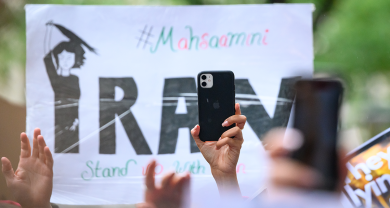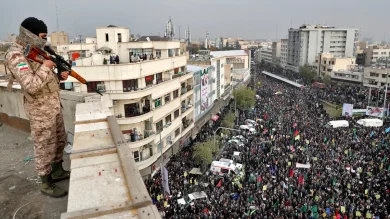In the face of state violence, censorship, and systemic oppression, Iranian women have emerged as powerful agents of resistance. Their fight for freedom, equality, and dignity has moved far beyond the streets and into the digital realm. Using technology—social media, encrypted messaging apps, virtual private networks (VPNs), and citizen journalism—they are waging a powerful form of digital resistance against the Islamic Republic’s most feared enforcer of control: the Islamic Revolutionary Guard Corps (IRGC).
The IRGC has long been responsible for enforcing state ideology through surveillance, censorship, online repression, and arrests of digital dissidents. However, Iranian women have learned to adapt and overcome, using digital tools to organize, inform, and inspire—turning technology into a weapon of freedom rather than fear.
This report explores:
• The IRGC’s digital control apparatus.
• How Iranian women are using technology to fight back.
• Case studies of prominent digital resistance figures.
• The risks and consequences they face.
• The role of global solidarity in supporting their struggle.
1. The IRGC’s Digital Control Apparatus
The IRGC’s Cyber Unit—also known as “Gerdab”—is tasked with monitoring and suppressing digital dissent. Their strategy includes:
A. Surveillance and Targeting
• Monitoring social media for “subversive” activity.
• Identifying and arresting users posting content critical of the regime.
• Infiltrating activist groups through fake profiles and phishing attacks.
B. Censorship and Filtering
• Blocking popular platforms like Twitter, Facebook, and Telegram.
• Imposing internet blackouts during protests.
• Banning VPN usage and criminalizing circumvention tools.
C. Digital Propaganda
• Disseminating state narratives.
• Launching smear campaigns against women activists.
• Publishing forced confessions and false allegations against critics.
Despite this vast apparatus of control, Iranian women have turned technology into a tool of liberation.
2. How Iranian Women Use Technology for Resistance
A. Social Media as a Protest Platform
Social media is a lifeline for Iranian women in voicing dissent. Platforms like Instagram, Telegram, Twitter (X), and Clubhouse have been used to:
• Document state violence in real time.
• Organize flash protests.
• Share stories of abuse, imprisonment, and survival.
Example: #MahsaAmini
The 2022 death of Mahsa Amini sparked a nationwide uprising. Hashtags like #MahsaAmini and #WomenLifeFreedom trended globally, powered largely by Iranian women on social media.
B. Encrypted Messaging and Coordination
With public platforms under surveillance, women activists rely on:
• Signal and WhatsApp for encrypted communications.
• Telegram channels for coordinating protests and spreading uncensored news.
• Peer-to-peer apps like Briar when networks go down.
These tools allow activists to:
• Evade government tracking.
• Organize securely and anonymously.
• Keep the momentum alive under crackdown conditions.
C. Citizen Journalism and Exposure
Women have become citizen journalists, recording:
• Police violence against protesters.
• Forced hijab enforcement by the morality police.
• Abuse in prisons, including Qarchak and Evin.
They share videos, testimonies, and documents with:
• International media outlets.
• Human rights organizations.
• Diaspora networks.
D. Online Campaigns and Hashtag Movements
Iranian women have pioneered impactful digital campaigns such as:
• #MyStealthyFreedom: Encouraging women to post hijab-free selfies.
• #WhiteWednesdays: A weekly protest against mandatory hijab laws.
• #StopExecutionInIran: Raising awareness about political executions.
• #FreeIranianWomen: Demanding the release of imprisoned activists.
These campaigns generate global awareness and keep international pressure on the regime.
3. Case Studies: Brave Women Behind Digital Resistance
A. Masih Alinejad
• Iranian journalist and exiled activist.
• Founder of #MyStealthyFreedom and #WhiteWednesdays.
• Target of IRGC assassination and kidnapping plots.
• Uses Instagram and Twitter to amplify Iranian women’s voices.
B. Niloofar Hamedi and Elaheh Mohammadi
• Two journalists who broke the story of Mahsa Amini’s death.
• Arrested and charged with “collaborating with hostile powers.”
• Their reporting went viral globally before their imprisonment.
C. Sepideh Gholian
• Citizen journalist who live-tweeted and documented prison abuse.
• Despite repeated arrests and torture, continues to expose IRGC crimes.
• Her videos from inside Evin prison became symbolic.
4. Risks and Consequences for Digital Activism
Using digital tools in Iran comes with grave dangers:
• Arbitrary arrests for social media posts.
• Long prison sentences for “propaganda against the state.”
• Torture to force confessions.
• Threats to family members.
• Assassination attempts abroad.
The IRGC’s cyber arm has intensified targeting of women who gain international attention, particularly those:
• Associated with Western media.
• Promoting women’s rights campaigns.
• Working with diaspora organizations.
5. Global Solidarity and the Role of Tech Platforms
A. Platform Responsibility
Social media companies must:
• Strengthen encryption and protect user data.
• Fight IRGC-linked propaganda and disinformation bots.
• Respond faster to Iranian government takedown requests.
B. Support from Tech NGOs
Organizations like Access Now, Tor Project, and Internet Freedom Foundation provide:
• Digital security training.
• VPN and circumvention tools.
• Safe channels for whistleblowers and activists.
C. Role of the Diaspora
Iranian women in the diaspora:
• Translate and amplify content.
• Fund tech access inside Iran.
• Build bridges to media and advocacy networks.
6. Recommendations for the International Community
1. Protect Iranian Women Online
• Provide access to secure communication tools.
• Train activists in digital safety.
• Grant asylum to digital resistance leaders at risk.
2. Sanction IRGC Cyber Units
• Impose sanctions on IRGC cyber officers.
• Target companies providing surveillance tools to Iran.
3. Amplify Voices
• Media must prioritize voices of Iranian women.
• Governments should include women-led tech resistance in foreign policy.
Conclusion
In the shadows of internet blackouts and digital crackdowns, Iranian women are fighting back—not just with their feet in the streets, but with their fingers on keyboards and phones. Through digital tools, they are documenting truth, building community, and mobilizing global outrage.
Join Our Newsletter!
Stay informed with the latest updates, news, and ways to take action in the fight for justice and global security. Sign up now to get updates delivered straight to your inbox!





